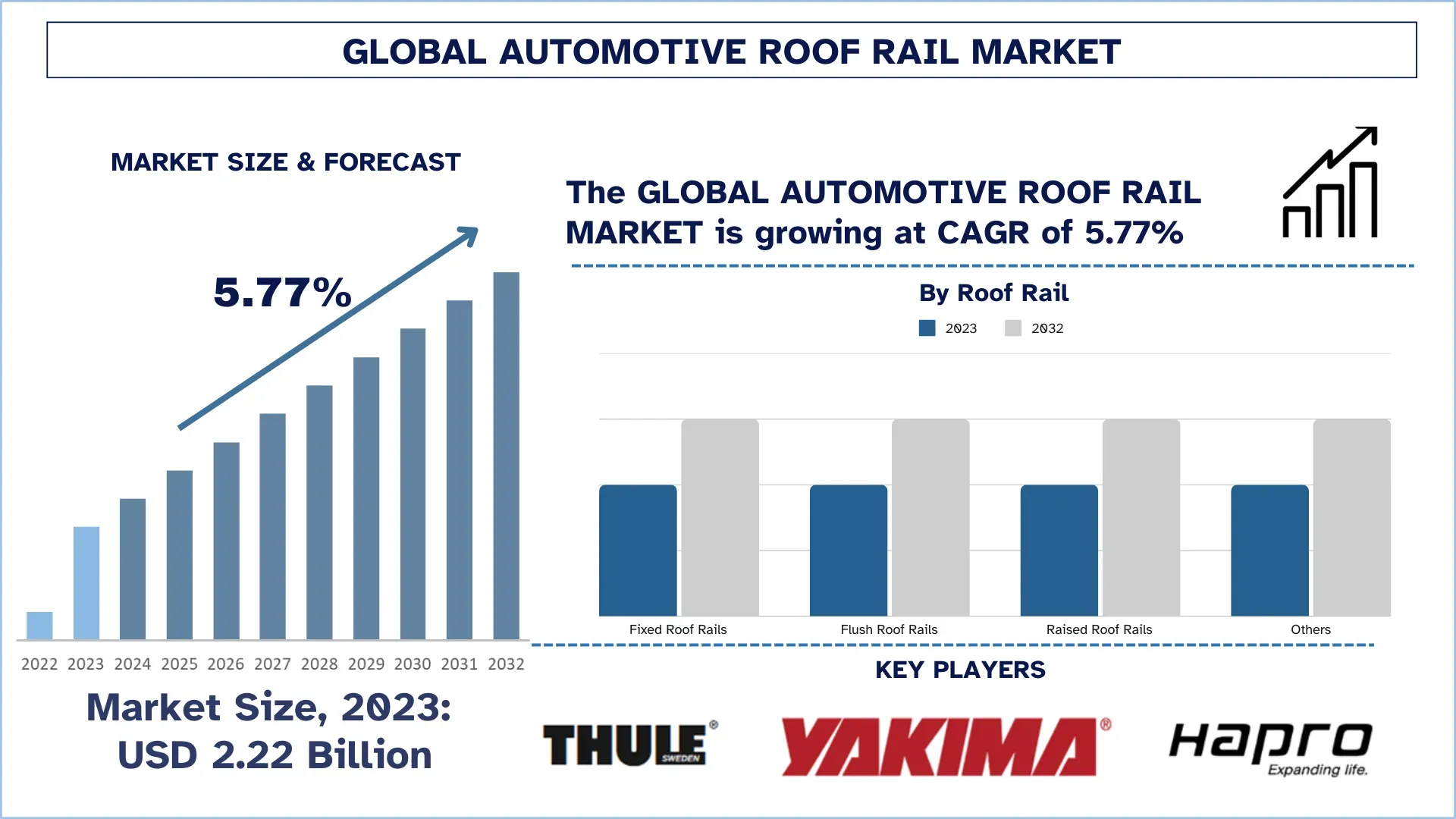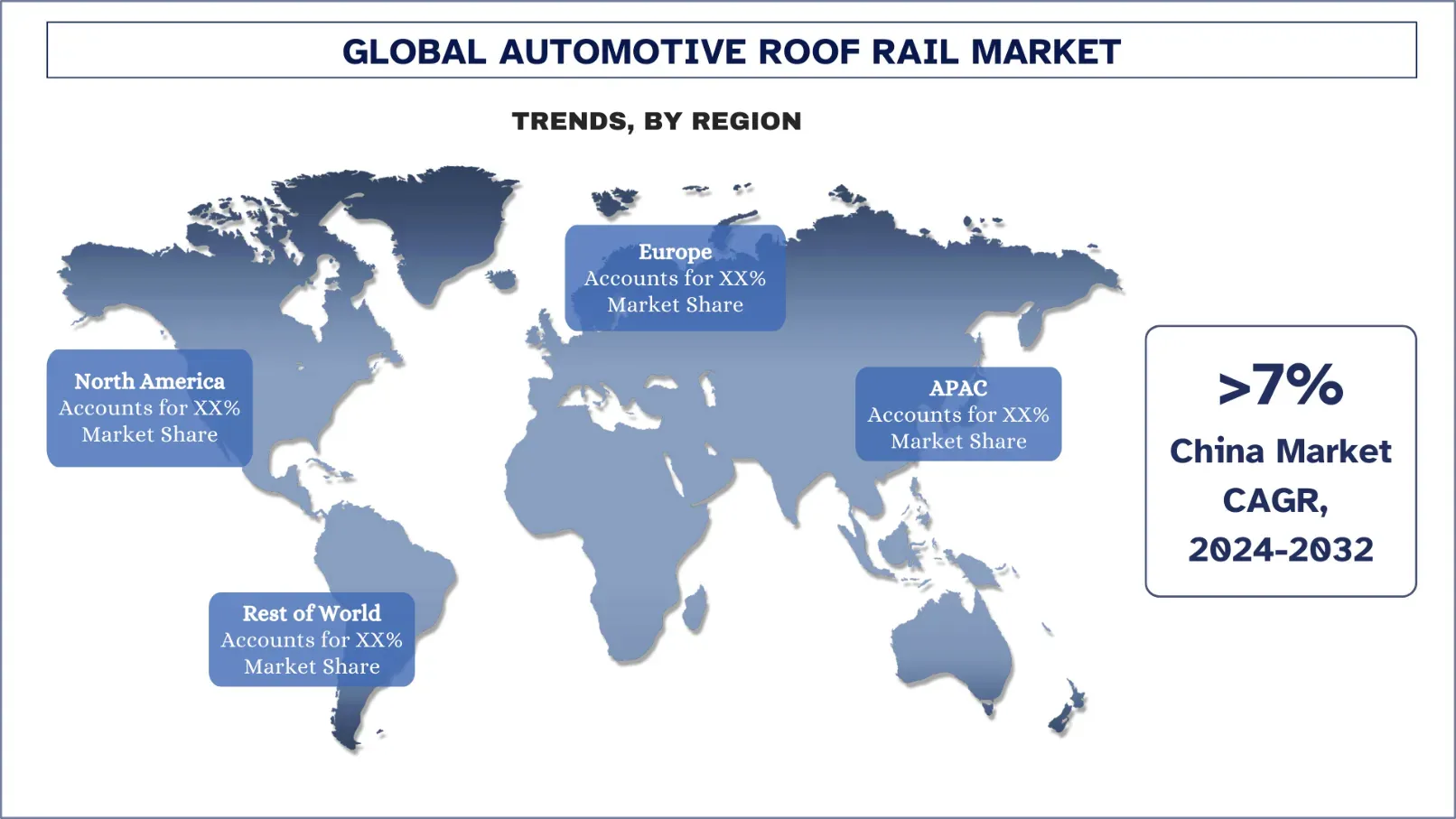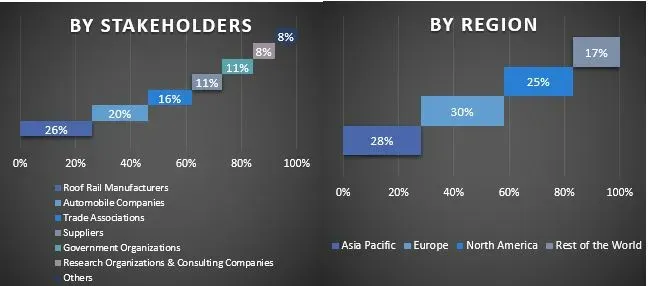- Home
- About Us
- Industry
- Services
- Reading
- Contact Us
Automotive Roof Rail Market: Current Analysis and Forecast (2024-2032)
Emphasis on Roof Rail (Fixed Roof Rails, Flush Roof Rails, Raised Roof Rails, and Others); Material (Aluminum, Steel, Composite Plastic, and Others); Vehicle (Passenger Cars and Commercial Vehicles); Sales Channel (OEM and Aftermarket); and Region/Country

Automotive Roof Rail Market Size & Forecast
The Automotive Roof Rail Market was valued at USD 2.22 billion in 2023 and is expected to grow at a steady CAGR of around 5.77% during the forecast period (2024-2032). The growth is primarily driven by the rise in SUV and Crossover popularity and the growing popularity of outdoor and adventure activities.
Automotive Roof Rail Market Analysis
The Automotive Roof Rail Market is witnessing a steady growth rate within the forecast period. The automotive roof rail market is driven by technological progress along with ever-increasing demand for improved aesthetics, functionality, and safety in vehicles. Apart from that, demand has been fueled by the increased adoption of integrated and detached roof rails in passenger cars and SUVs. With the ability to transport cargo more securely while minimizing wind noise, it has also contributed to greater overall vehicle performance. These growths in the market have been further influenced by trends in consumer customization as adjustable and modular roof rails find adoption by different vehicles and consumers. Sustainable materials and advanced coatings have contributed toward enhancing the longevity of roof rails together with compliance with sustainability objectives set by automobile manufacturers. Further, the current market shift toward electric vehicles (EVs) and autonomous vehicles as these are rapidly gaining traction across the industry, prompting car manufacturers to direct their efforts at producing lightweight and highly tested designs that go well with battery efficiency and aerodynamics.
Automotive Roof Rail Market Trends
Adoption of Lightweight and Aerodynamic Designs
This is one of the significant patterns or trends that goes with the Global Automotive Roof Rail Market, which is segregating in this case lightweight and aerodynamic designs for improving fuel efficiency while reducing the carbon footprint of automobiles. This trend is primarily because manufacturers have taken the course of giving roof rails for advanced materials such as aluminum alloys, high-strength composites, or carbon fiber due to increasing concerns for sustainable practices and strengthening of environmental regulations. These advanced materials will not only reduce the overall weight of the vehicle but also give excellent structural durability and load capacity within the roof rail system.
Moreover, the trend moving along with roof rail designs is the shift toward electric vehicles (EVs). Electric vehicle manufacturers emphasize aerodynamics to increase the electric range of the battery; therefore, they must have low tire flooring and smooth contours along with reduced drag by roof rails. Similar applications will also manifest for the aftermarket roof rail systems, which will include the rollouts by manufacturers such as Yakima and Thule, among others, of products aimed at EV compatibility.

Asia Pacific Dominated the Automotive Roof Rail Market
The Asia Pacific automotive roof rail market dominated the market and is expected to behave in the same manner in the forecast period. The passenger car and SUV production and sales have driven the growth of the Asia Pacific automotive roof rail market with a significantly larger contribution from China, India, and Japan. These countries have very strong bases for automobile manufacturing, with China being the largest automobile producer in the world. The growing demand for SUVs and crossovers that usually come with roof rails for utility and aesthetics has greatly added to the market growth. The growing urbanization, increasing disposable income, and changing consumer lifestyles are further contributing to the use of roof-mounted cargo solutions. Additionally, the rise in adventure tourism and off-road vehicles in India has boosted the demand for aftermarket roof rails and crossbars. Also, automotive OEMs in the region like Toyota, Hyundai, Honda, and Tata Motors are equipping their new models with integrated or flush roof rails under global design trends and regulatory standards. The increasing penetration of electric vehicles (EVs) and hybrid cars has also brought in more lightweight aluminum and composite roof rails to facilitate better fuel efficiency and aerodynamics in this fast-growing region of Asia. Moreover, the region offers low production costs, a vast supply chain, and increasing automotive exports, making Asia Pacific one of the leading regions in the global roof rail market. All these factors contribute to the dominance of the Asia Pacific market in the automotive roof rail industry.

Automotive Roof Rail Industry Competitive Landscape
The automotive roof rail market is competitive and concentrated, with few global and international players. The key players are adopting different growth strategies to enhance their market presence, such as partnerships, agreements, collaborations, new product launches, geographical expansions, and mergers and acquisitions.
Top Automotive Roof Rail Manufacturing Companies
Some major players operating in the market are Thule Group, Yakima, Inc., VDL Hapro, CRUZBER SAU, Rhino Rack Australia Pty Limited, Atera GmbH, JAC Products, AISIN CORPORATION, Mont Blanc Group AB, and KAMEI Automotive GmbH.
Automotive Roof Rail Market News
In 2024, Ford proudly introduced its groundbreaking innovation electrically powered deployable roof rack system. The novel technology operates without any power connectivity, unlike Rivian's similar patents. This system is expressly designed for Ford pickup truck EVs, with roof rails able to be lowered at higher speeds, allowing for enhanced aerodynamics and considerably larger range for the vehicle.
In May 2023, Cruzber announced the new generation of Cruz Roof Bars which have stepped forwards in performance, safety, and ease of use. Made from high-quality aluminum, these roof bars are known for great strength and less weight. The design is focused on improving aerodynamics, which translates to less fuel consumption and much-reduced CO2 emissions. These roof bars feature looks that would blend in any modern-flowing lines, excellent corrosion resistance to offer long-term durability, and simplified installation for multiple mounting on a myriad of vehicles. The new Cruz Roof Bars feature compatibility with a variety of accessories and therefore provide a versatile solution for cargo transportation, be it for everyday use or heavy-duty renown.
Automotive Roof Rail Market Report Coverage
Report Attribute | Details |
Base year | 2023 |
Forecast period | 2024-2032 |
Growth momentum | Accelerate at a CAGR of 5.77% |
Market size 2023 | USD 2.22 billion |
Regional analysis | North America, Europe, APAC, Rest of the World |
Major contributing region | Asia Pacific dominated the market in 2023 |
Key countries covered | The US, Canada, Germany, The UK, Spain, Italy, France, China, Japan, and India |
Companies profiled | Thule Group, Yakima, Inc., VDL Hapro, CRUZBER SAU, Rhino Rack Australia Pty Limited, Atera GmbH, JAC Products, AISIN CORPORATION, Mont Blanc Group AB, and KAMEI Automotive GmbH |
Report Scope | Market Trends, Drivers, and Restraints; Revenue Estimation and Forecast; Segmentation Analysis; Demand and Supply Side Analysis; Competitive Landscape; Company Profiling |
Segments Covered | By Roof Rail, By Material, By Vehicle, By Sales Channel, and By Region/Country |
Reasons to buy this report:
The study includes market sizing and forecasting analysis validated by authenticated key industry experts.
The report presents a quick review of overall industry performance at one glance.
The report covers an in-depth analysis of prominent industry peers with a primary focus on key business financials, product portfolios, expansion strategies, and recent developments.
Detailed examination of drivers, restraints, key trends, and opportunities prevailing in the industry.
The study comprehensively covers the market across different segments.
Deep dive regional level analysis of the industry.
Customization Options:
The global automotive roof rail market can further be customized as per the requirement or any other market segment. Besides this, UMI understands that you may have your own business needs, hence feel free to contact us to get a report that completely suits your requirements.
Table of Content
Research Methodology for the Automotive Roof Rail Market Analysis (2024-2032)
Analyzing the historical market, estimating the current market, and forecasting the future market of the global automotive roof rail market were the three major steps undertaken to create and analyze the adoption of automotive roof rail in major regions globally. Exhaustive secondary research was conducted to collect the historical market numbers and estimate the current market size. Secondly, to validate these insights, numerous findings and assumptions were taken into consideration. Moreover, exhaustive primary interviews were also conducted with industry experts across the value chain of the global automotive roof rail market. Post assumption and validation of market numbers through primary interviews, we employed a top-down/bottom-up approach to forecasting the complete market size. Thereafter, market breakdown and data triangulation methods were adopted to estimate and analyze the market size of segments and sub-segments of the industry pertains to. Detailed methodology is explained below:
Analysis of Historical Market Size
Step 1: In-Depth Study of Secondary Sources:
Detail secondary study was conducted to obtain the historical market size of the automotive roof rail through company internal sources such as annual reports & financial statements, performance presentations, press releases, etc., and external sources including journals, news & articles, government publications, competitor publications, sector reports, third-party database, and other credible publications.
Step 2: Market Segmentation:
After obtaining the historical market size of the automotive roof rail market, we conducted a detailed secondary analysis to gather historical market insights and share for different segments & sub-segments for major regions. Major segments included in the report are roof rail, material, vehicle, and sales channel. Further country-level analyses were conducted to evaluate the overall adoption of testing models in that region.
Step 3: Factor Analysis:
After acquiring the historical market size of different segments and sub-segments, we conducted a detailed factor analysis to estimate the current market size of the automotive roof rail. Further, we conducted factor analysis using dependent and independent variables such as roof rail, material, vehicle, and sales channel of the automotive roof rail market. A thorough analysis was conducted of demand and supply-side scenarios considering top partnerships, mergers and acquisitions, business expansion, and product launches in the automotive roof rail market sector across the globe.
Current Market Size Estimate & Forecast
Current Market Sizing: Based on actionable insights from the above 3 steps, we arrived at the current market size, key players in the global automotive roof rail market, and market shares of the segments. All the required percentage shares split, and market breakdowns were determined using the above-mentioned secondary approach and were verified through primary interviews.
Estimation & Forecasting: For market estimation and forecast, weights were assigned to different factors including drivers & trends, restraints, and opportunities available for the stakeholders. After analyzing these factors, relevant forecasting techniques i.e., the top-down/bottom-up approach were applied to arrive at the market forecast for 2032 for different segments and sub-segments across the major markets globally. The research methodology adopted to estimate the market size encompasses:
The industry’s market size, in terms of revenue (USD) and the adoption rate of the automotive roof rail market across the major markets domestically
All percentage shares, splits, and breakdowns of market segments and sub-segments
Key players in the global automotive roof rail market in terms of products offered. Also, the growth strategies adopted by these players to compete in the fast-growing market.
Market Size and Share Validation
Primary Research: In-depth interviews were conducted with the Key Opinion Leaders (KOLs) including Top Level Executives (CXO/VPs, Sales Head, Marketing Head, Operational Head, Regional Head, Country Head, etc.) across major regions. Primary research findings were then summarized, and statistical analysis was performed to prove the stated hypothesis. Inputs from primary research were consolidated with secondary findings, hence turning information into actionable insights.
Split of Primary Participants in Different Regions

Market Engineering
The data triangulation technique was employed to complete the overall market estimation and to arrive at precise statistical numbers for each segment and sub-segment of the global automotive roof rail market. Data was split into several segments & sub-segments post studying various parameters and trends in the areas of the roof rail, material, vehicle, and sales channel in the global automotive roof rail market.
The main objective of the Global Automotive Roof Rail Market Study
The current & future market trends of the global automotive roof rail market were pinpointed in the study. Investors can gain strategic insights to base their discretion for investments on the qualitative and quantitative analysis performed in the study. Current and future market trends determined the overall attractiveness of the market at a regional level, providing a platform for the industrial participant to exploit the untapped market to benefit from a first-mover advantage. Other quantitative goals of the studies include:
Analyze the current forecast and market size of the automotive roof rail market in terms of value (USD). Also, analyze the current forecast and market size of different segments and sub-segments.
Segments in the study include areas of roof rail, material, vehicle, and sales channel.
Define and analysis of the regulatory framework for the automotive roof rail
Analyze the value chain involved with the presence of various intermediaries, along with analyzing customer and competitor behaviors of the industry.
Analyze the current forecast and market size of the automotive roof rail market for the major region.
Major countries of regions studied in the report include Asia Pacific, Europe, North America, and the Rest of the World
Company profiles of the automotive roof rail market and the growth strategies adopted by the market players to sustain the fast-growing market.
Deep dive regional level analysis of the industry
Frequently Asked Questions FAQs
Q1: What is the current market size and growth potential of the automotive roof rail market?
The automotive roof rail market was valued at USD 2.22 billion in 2023 and is expected to grow at a CAGR of 5.77% during the forecast period (2024-2032).
Q2: What are the driving factors for the growth of the automotive roof rail market?
The growth is primarily driven by the rise in SUV and Crossover popularity and the growing popularity of outdoor and adventure activities.
Q3: Which segment has the largest automotive roof rail market share by Roof Rail Type?
The raised roof rails segment has the largest automotive roof rail market share by Roof Rail.
Q4: What are the emerging technologies and trends in the automotive roof rail market?
The adoption of lightweight material and aerodynamic designs is one of the significant trends in the automotive roof rail market.
Q5: Which region will dominate the automotive roof rail market?
Asia Pacific is expected to dominate the market during the forecast period.
Related Reports
Customers who bought this item also bought










